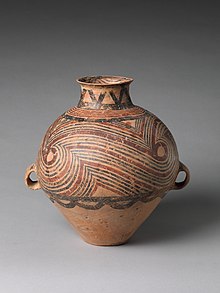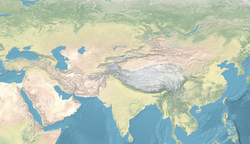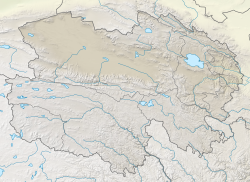Lajia (Chinese: 喇家; pinyin: Lǎjiā) is a Bronze Age archaeological site in the upper reaches of the Yellow River, on the border between the Chinese provinces of Gansu and Qinghai. As at other sites of the Qijia culture (c. 2300–1500 BCE), the people of Lajia had an agricultural economy based primarily on millet cultivation and sheep herding. They also kept pigs for use in ritual activities, including making oracle bones, and experimented with a high temperature-fired pottery described as proto-porcelain. The world's oldest known noodles were discovered at the site in 2005.
喇家 | |
 | |
| Alternative name | Lajia Ruins |
|---|---|
| Location | China |
| Region | Qinghai |
| Coordinates | 35°51′51″N 102°48′37″E / 35.86405°N 102.81025°E |
| History | |
| Cultures | Qijia |
| Events | Earthquake Mudslide Flood |
| Site notes | |
| Excavation dates | 1999, 2000, 2001, 2002, 2003, 2004[1] |
| Management | Lajia Site Museum |

A natural disaster buried the site and killed many of its inhabitants in around 1920 BCE, but archaeologists continue to debate the exact cause of the catastrophe.
Background
editLajia is associated with the Qijia culture, an archaeological culture of northwestern China dated to the late Neolithic and early Bronze Age periods (c. 2300–1500 BCE).[2][3] Excavations at the site have unearthed various Qijia artifacts, including pottery, rings, stone, weapons and jade flakes.[3][4] Its moat is also typical of Qijia sites.[3] Some metal artifacts from Qijia sites are similar in style to finds from Central Asia and Siberia, suggesting frequent contact and cultural interactions.[5]
For most of the Qijia period, the Guanting Basin was relatively warm and moist.[6][7] The staple cereal crop of the Qijia culture was millet, which requires high rainfall and temperature to grow.[8] A significant decrease in mean annual precipitation and mean annual temperature occurred between 1800 and 1400 BCE.[6] This coincided with the demise of the Qijia culture, perhaps because their reliance on millet cultivation meant they could not adapt to the changing climate.[9]
Finds
editThe world's oldest known noodles have been found at Lajia.[10] The thin yellow strands were found in an upturned pot in 2005 and radiocarbon dated to around 4,000 years ago (c. 2000 BCE).[10] They were originally thought to be made from a combination of foxtail and broomcorn millet,[11] but subsequent experiments have showed millet alone could not have formed noodles, and that the Lajia noodles must have incorporated other starches, perhaps barley or wheat.[12] Remnants of grains, including foxtail and broomcorn millet, and stems of Hordeum and Triticum species, have also been found at the site. The inhabitants used stone knives to process, peel, and cut them.[13]
The inhabitants of Lajia kept domesticated sheep, pigs and cattle. Sheep were primarily used for their milk and wool, but were also the main source of meat. Pigs were not slaughtered for their meat, but used in ritual activities.[14] Pig scapulae were modified for use as oracle bones for divination and, as is frequently seen at Qijia sites, deposited in burials.[5][14][15] Wild deer remains have also been found at the site; they must have been hunted by the people of Lajia, or traded from elsewhere.[14]
The pottery used at Lajia included pieces fired at extremely high temperatures to produce a glassy surface, a kind of proto-porcelain. Clays rich in flux were selected for their ability to vitrify at these temperatures. However, the technique used by the Lajia potters was unreliable and required large amounts of fuel, which is perhaps why the use of this proto-porcelain remained uncommon.[16]
Destruction
editLajia was destroyed by a natural disaster at Jishi Gorge that buried the site in mud and killed many of its inhabitants.[17] The cause of this catastrophe is debated. The excavators of the site originally proposed a combination of simultaneous earthquakes and flooding of the Yellow River and mountain gullies.[17] More recent research has pointed to localised flash flooding and severe mudflows, which are known to occur in the area and could have been exacerbated by human activity.[18][19] A controversial[20] 2016 study proposed that an earthquake in 1920 BCE triggered a catastrophic outburst flood of the Yellow River, which the authors incorrectly linked to the legendary Great Flood that, according to traditional Chinese historiography, led to the rise of the Xia dynasty.[21][22] Other researchers considered this implausible,[23][24][25] pointing out that the Lajia disaster took place over a hundred years after the 1920 earthquake,[26] and that the lake that is supposed to have burst to produce this flood ceased to exist nearly 2000 years prior.[24]
The simultaneous deaths of many people at Lajia provides a rare opportunity to study family relationships within prehistoric households. Analysis of ancient DNA from the remains of twelve people in one house showed that they belonged to multiple maternal lineages, ruling out a matrilineal social structure.[27]
References
edit- ^ Ye, Maolin (28 April 2005). "Archaeological discoveries at the Lajia site, Minhe County, Qinghai Province". Chinese Archaeology. Archived from the original on 25 June 2019. Retrieved 3 January 2017.
- ^ Dittmar, Jenna M.; Berger, Elizabeth; Zhan, Xiaoya; Mao, Ruilin; Wang, Hui; Yeh, Hui-Yuan (December 2019). "Skeletal evidence for violent trauma from the bronze age Qijia culture (2,300-1,500 BCE), Gansu Province, China". International Journal of Paleopathology. 27: 66–79. doi:10.1016/j.ijpp.2019.08.002. hdl:2164/23411. ISSN 1879-9817. PMID 31606648.
- ^ a b c "Archaeological discoveries at the Lajia site, Minhe County, Qinghai Province". www.kaogu.cn. Archived from the original on 24 July 2021. Retrieved 17 May 2021.
- ^ "Prehistoric catastrophic remains found again at Lajia Site, Qinghai". kaogu.cn. Archived from the original on 2 April 2019. Retrieved 17 May 2021.
- ^ a b Di Cosmo, Nicola (13 March 1999), "The Northern Frontier in Pre–Imperial China", The Cambridge History of Ancient China, Cambridge University Press, pp. 885–966, doi:10.1017/chol9780521470308.015, ISBN 978-1-139-05370-9
- ^ a b Zhao, Hui; Huang, Chun Chang; Wang, Huanye; Liu, Weiguo; Qiang, Xiaoke; Xu, Xinwen; et al. (October 2018). "Mid-late Holocene temperature and precipitation variations in the Guanting Basin, upper reaches of the Yellow River". Quaternary International. 490: 74–81. Bibcode:2018QuInt.490...74Z. doi:10.1016/j.quaint.2018.05.009. ISSN 1040-6182.
- ^ Dong, Guanghui; Jia, Xin; An, Chengbang; Chen, Fahu; Zhao, Yan; Tao, Shichen; Ma, Minmin (January 2012). "Mid-Holocene climate change and its effect on prehistoric cultural evolution in eastern Qinghai Province, China". Quaternary Research. 77 (1): 23–30. Bibcode:2012QuRes..77...23D. doi:10.1016/j.yqres.2011.10.004. ISSN 0033-5894. S2CID 128679698.
- ^ Song, Jixiang; Zhao, Zhijun; Fuller, Dorian Q. (7 July 2012). "The archaeobotanical significance of immature millet grains: an experimental case study of Chinese millet crop processing". Vegetation History and Archaeobotany. 22 (2): 141–152. doi:10.1007/s00334-012-0366-y. ISSN 0939-6314. S2CID 129911109.
- ^ An, Cheng-Bang; Tang, Lingyu; Barton, Loukas; Chen, Fa-Hu (May 2005). "Climate change and cultural response around 4000 cal yr B.P. in the western part of Chinese Loess Plateau". Quaternary Research. 63 (3): 347–352. Bibcode:2005QuRes..63..347A. doi:10.1016/j.yqres.2005.02.004. ISSN 0033-5894. S2CID 128546916.
- ^ a b "Oldest noodles unearthed in China". BBC News. 12 October 2005. Archived from the original on 17 December 2010. Retrieved 17 May 2021.
- ^ "4,000-Year-Old Noodles Found in China". National Geographic. 12 October 2005. Archived from the original on 19 May 2021. Retrieved 17 May 2021.
- ^ Ge, W.; Liu, L.; Chen, X.; Jin, Z. (2011). "Can noodles be made from millet? An experimental investigation of noodle manufacture together with starch grain analyses". Archaeometry. 53: 194–204. doi:10.1111/j.1475-4754.2010.00539.x.
- ^ Ma, Zhikun; Li, Quan; Huan, Xiujia; Yang, Xiaoyan; Zheng, Jingyun; Ye, Maolin (22 February 2014). "Plant microremains provide direct evidence for the functions of stone knives from the Lajia site, northwestern China". Chinese Science Bulletin. 59 (11): 1151–1158. Bibcode:2014ChSBu..59.1151M. doi:10.1007/s11434-014-0174-0. ISSN 1001-6538. S2CID 95717366.
- ^ Honghai, Chen (15 March 2013), "The Qijia Culture of the Upper Yellow River Valley", A Companion to Chinese Archaeology, Chichester, UK: John Wiley & Sons, Ltd, pp. 103–124, doi:10.1002/9781118325698.ch6, ISBN 978-1-118-32569-8
- ^ Zhou, X. Q.; Cui, J. F.; Ren, X. Y.; Wang, Q. Q.; Du, W.; Du, Z. W.; Liu, X. Y. (6 December 2018). "The Earliest High‐Fired Glazed Ceramic in China: Evidence from a Glazed Ceramic Sample from the Lajia Site, Qinghai Province". Archaeometry. 61 (3): 588–599. doi:10.1111/arcm.12447. ISSN 0003-813X.
- ^ a b Yang, Xiaoyan; Xia, Zhengkai; Ye, Maolin (1 September 2003). "Prehistoric disasters at Lajia Site, Qinghai, China". Chinese Science Bulletin. 48 (17): 1877–1881. Bibcode:2003ChSBu..48.1877Y. doi:10.1007/BF03184071. ISSN 1861-9541. S2CID 96531032.
- ^ Zhao, Hui; Huang, Chun Chang; Zheng, Zixing; Hu, Ying; Zhang, Yuzhu; Guo, Yongqiang; Zhou, Qiang (September 2017). "New evidence for the catastrophic demise of a prehistoric settlement (the Lajia Ruins) in the Guanting Basin, upper Yellow River, NW China". Journal of Asian Earth Sciences. 146: 134–141. Bibcode:2017JAESc.146..134Z. doi:10.1016/j.jseaes.2017.05.019. ISSN 1367-9120.
- ^ Wang, Haiyan; Huang, Chun Chang; Pang, Jiangli; Zhou, Yali; Cuan, Yuda; Guo, Yongqiang; et al. (January 2021). "Catastrophic flashflood and mudflow events in the pre-historical Lajia Ruins at the northeast margin of the Chinese Tibetan Plateau". Quaternary Science Reviews. 251: 106737. Bibcode:2021QSRv..25106737W. doi:10.1016/j.quascirev.2020.106737. ISSN 0277-3791.
{{cite journal}}: CS1 maint: numeric names: authors list (link) - ^ Wu, Qinglong; Zhao, Zhijun; Liu, Li; Granger, Darryl E.; Wang, Hui; Cohen, David J.; Wu, Xiaohong; Ye, Maolin; Bar-Yosef, Ofer; Lu, Bin; Zhang, Jin (31 March 2017). "Response to Comments on "Outburst flood at 1920 BCE supports historicity of China's Great Flood and the Xia dynasty"". Science. 355 (6332): 1382–1382. doi:10.1126/science.aal1325. ISSN 0036-8075. PMID 28360294.
- ^ Wu, Qinglong; Zhao, Zhijun; Liu, Li; Granger, Darryl E.; Wang, Hui; Cohen, David J.; Wu, Xiaohong; Ye, Maolin; Bar-Yosef, Ofer; Lu, Bin; Zhang, Jin (5 August 2016). "Outburst flood at 1920 BCE supports historicity of China's Great Flood and the Xia dynasty". Science. 353 (6299): 579–582. doi:10.1126/science.aaf0842. ISSN 0036-8075. PMID 27493183.
- ^ Li, Le; Chen, Jun; Hedding, David William; Fu, Yuanhe; Ye, Maolin; Li, Gaojun (16 October 2019). "Uranium isotopic constraints on the nature of the prehistoric flood at the Lajia site, China". Geology. 48 (1): 15–18. doi:10.1130/g46306.1. ISSN 0091-7613.
- ^ Wu, Wenxiang; Dai, Junhu; Zhou, Yang; Ge, Quansheng (31 March 2017). "Comment on "Outburst flood at 1920 BCE supports historicity of China's Great Flood and the Xia dynasty"". Science. 355 (6332): 1382–1382. doi:10.1126/science.aal1278. ISSN 0036-8075. PMID 28360291.
- ^ a b Han, Jian-Chiu (30 March 2017). "Comment on "Outburst flood at 1920 BCE supports historicity of China's Great Flood and the Xia dynasty"". Science. 355 (6332): 1382.3–1382. Bibcode:2017Sci...355Q1382H. doi:10.1126/science.aal1369. ISSN 0036-8075. PMID 28360292.
- ^ Huang, Chun Chang; Zhou, Yali; Zhang, Yuzhu; Guo, Yongqiang; Pang, Jiangli; Zhou, Qiang; Liu, Tao; Zha, Xiaochun (31 March 2017). "Comment on "Outburst flood at 1920 BCE supports historicity of China's Great Flood and the Xia dynasty"". Science. 355 (6332): 1382–1382. doi:10.1126/science.aak9657. ISSN 0036-8075. PMID 28360293.
- ^ Dong, GuangHui; Zhang, FanYu; Liu, FengWen; Zhang, DongJu; Zhou, AiFeng; Yang, YiShi; Wang, GongHui (18 July 2017). "Multiple evidences indicate no relationship between prehistoric disasters in Lajia site and outburst flood in upper Yellow River valley, China". Science China Earth Sciences. 61 (4): 441–449. doi:10.1007/s11430-017-9079-3. ISSN 1674-7313. S2CID 134330532.
- ^ Gao, Shi-Zhu; Yang, Yi-Dai; Xu, Yue; Zhang, Quan-Chao; Zhu, Hong; Zhou, Hui (2007). "Tracing the genetic history of the Chinese people: Mitochondrial DNA analysis of aneolithic population from the Lajia site". American Journal of Physical Anthropology. 133 (4): 1128–1136. doi:10.1002/ajpa.20623. ISSN 0002-9483. PMID 17506489.

